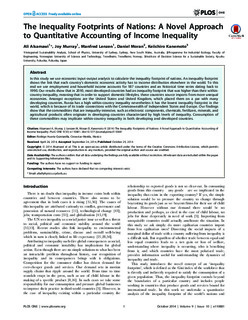The inequality footprints of nations: A novel approach to quantitative accounting of income inequality
Journal article, Peer reviewed
Permanent lenke
http://hdl.handle.net/11250/2366949Utgivelsesdato
2014Metadata
Vis full innførselSamlinger
Sammendrag
In this study we use economic input-output analysis to calculate the inequality footprint of nations. An inequality footprint shows the link that each country's domestic economic activity has to income distribution elsewhere in the world. To this end we use employment and household income accounts for 187 countries and an historical time series dating back to 1990. Our results show that in 2010, most developed countries had an inequality footprint that was higher than their within-country inequality, meaning that in order to support domestic lifestyles, these countries source imports from more unequal economies. Amongst exceptions are the United States and United Kingdom, which placed them on a par with many developing countries. Russia has a high within-country inequality nevertheless it has the lowest inequality footprint in the world, which is because of its trade connections with the Commonwealth of Independent States and Europe. Our findings show that the commodities that are inequality-intensive, such as electronic components, chemicals, fertilizers, minerals, and agricultural products often originate in developing countries characterized by high levels of inequality. Consumption of these commodities may implicate within-country inequality in both developing and developed countries.
